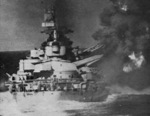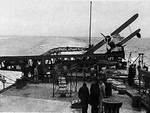Battle of Matapan
Contributor: C. Peter Chen
ww2dbaseItalian battleship Vittorio Veneto, eight cruisers, and 13 destroyers under the command of Admiral Angelo Iachino set to sea to hunt for a detected British convoy. As soon as the Italian ships left port, British intelligence decoded the messages indicating their sortie. As a result, Admiral Andrew Cunningham was sent with fleet of three battleships, one carrier, and nine destroyers from Alexandria to face the Italian fleet. On the morning of 28 Mar 1941, forward cruisers supported by Albacore torpedo-bombers of carrier Formidable met the Italian warships off the Peloponnesian coast of Greece. Italian Battleship Vittorio Veneto was only lightly damaged in the initial engagement, but it made Iachino realize that without air cover his fleet was at a disadvantage, therefore he ordered his fleet to return to port. Two follow-up air strikes failed to damage Vittorio Veneto, though successful in disabling the cruiser Pola.
ww2dbaseIachino's biggest failure entering this battle was caused by failings of Axis Intelligence. When he launched the sortie, he had the wrongful impression that the British fleet only had one battleship and no carriers at its disposal, so when the battleships opened fire at the distance of less than 4,000 yards, he was caught in a surprise. His quick response to withdraw his forces at the face of superior surface and air power would have saved his fleet, but he did not realize Cunningham's persistence. After sundown, aided by radar, Cunningham's ships detected Italian destroyers guarding the disabled Pola. Within five minutes of bombardment from battleships Barham, Valiant, and Warspite from a short range, the cruisers Fiume and Zara were destroyed. Italian destroyers Vittorio Alfieri and Giosué Carducci fought back, but were intercepted and sank by British destroyers. Pola was sunk by torpedoes after her crew had been taken off. When day broke, German bombers mounted a retaliatory strike on the British fleet, though to little effect.
ww2dbaseBy the time the remaining Italian ships escaped to port, they had already lost 2,400 men, including Vice Admiral Carlo Cattaneo of the cruiser Zara. The Italian loss of three heavy cruisers and two destroyers was a stark contrast from the damage suffered by the British. The British had only lost one torpedo bomber during the entire battle.
ww2dbaseThe Battle of Matapan is still highly regarded in British naval history, often compared with the famous victory at Trafalgar. This battle marked British naval dominance in the Mediterranean Sea for the rest of the war. Without the Mediterranean Sea under Italian Control, Germany could no longer supply its war efforts in North Africa with ease.
ww2dbaseSources: the Second World War, Wikipedia.
Last Major Update: Mar 2006
Battle of Matapan Interactive Map
Photographs
 |  |  |
Battle of Matapan Timeline
| 26 Mar 1941 | Italian battleship Vittorio Veneto, 5 cruisers, and 10 destroyers sortied out of Naples, Taranto, and Brindisi in Italy to patrol the area of the Mediterranean Sea between Egypt and Greece; the goal was to attack Allied convoys bringing troops and supplies to Greece. |
| 27 Mar 1941 | Battleship HMS Warspite, battleship HMS Barham, battleship HMS Valiant, carrier HMS Formidable, and nine destroyers of the British Mediterranean Fleet departed Alexandria, Egypt to hunt for an Italian fleet known to have departed bases in Italy. Four cruisers and four destroyers also departed from Piraeus, Greece, launching spotter planes to search for the Italian fleet, locating it at noon. |
| 28 Mar 1941 | 150 miles off Cape Matapan, Greece at 0635 hours, Italian seaplane spotted a group of four Allied cruisers, and three Italian cruisers moved in to attack, engaging in combat at 0812 hours, to be joined by the big guns of Italian battleships at 1055 hours; after the morning's exchange of shellfire, all four Allied cruisers were damaged by near misses. At 1200 and 1509 hours, Allied torpedo bombers from HMS Formidable attacked, putting battleship Vittorio Veneto out of action for about 90 minutes at the cost of one aircraft. At 1936 hours, HMS Formidable's aircraft returned, joined by land-based aircraft from Crete, Greece, putting cruiser Pola out of action, but failed to catch Vittorio Veneto as she had received temporary repairs and was already en route back to Taranto, Italy. After dark, British battleships HMS Barham, HMS Valiant, and HMS Warspite moved in within 3.5 kilometers of the Italian cruisers undetected, opening fire at 2330 hours on the unsuspecting Italians. |
| 29 Mar 1941 | British battleships HMS Barham, HMS Valiant, and HMS Warspite continued to shell the Italian fleet off Cape Matapan, Greece. Italian cruiser Fiume, cruiser Zara, destroyer Alfieri, and destroyer Carducci were sunk, while destroyer Oriani was heavily damaged. At 0400 hours, British destroyers HMS Jervis and HMS Nubian approached damaged Italian cruiser Pola, captured her crew, and sank her with torpedoes. British ships rescued 905 Italian sailors but hurriedly departed at daybreak, fearing Luftwaffe attack; the Royal Navy would provide coordinates of remaining survivors to Italian ship Gradisca to continue to rescue. The Battle of Cape Matapan would close with 5 Italian warships lost, killing 2,303 men; the British suffered only 3 killed, the air crew of a single torpedo bomber lost on 28 Mar 1941. |
| 31 Oct 1943 | The Hallfried, a Norwegian freighter of 2,968 tons, owned by P. Kleppe of Oslo was on route to Ardrossan in southwestern Scotland, United Kingdom with the combined convoys MKS-28/SL-138. The German submarine U-262 (Kapitänleutnant Rudolf Heinz Franke) fired 4 torpedoes (2 FAT and 2 T-3 types) then fired a GNAT torpedo at a destroyer that was acting as esc1943-10-31 The Hallfried, a Norwegian freighter of 2,968 tons, owned by P. Kleppe of Oslo was on route to Ardrossan in southwestern Scotland, United Kingdom with the combined convoys MKS-28/SL-138. The German submarine U-262 (Kapitänleutnant Rudolf Heinz Franke) fired 4 torpedoes (2 FAT and 2 T-3 types) then fired a GNAT torpedo at a destroyer that was acting as escort. Franke reported four detonations but only the Hallfried had been hit. Two of them struck her on the port side, first just forward of the bridge followed by the second at the engine room which caused the vessel to sink immediately. Only three of the crew managed to get away and were picked up after 45 minutes by the British destroyer HMS Wrestler (D35) 2 of the survivors in the water had lifevests on, but the third, who had been asleep when the attack occurred did not (in the same cabin there had also been 2 stokers and 1 of the British messboys, who all made it up on deck). They were pulled under by the suction as were the rest of the crew who were on deck. The English Able Seaman Thomas Shaw was able to get onto a raft that had floated free, while the other 2 were too far away to reach it. It was not unusual for British lads to join Norwegian ships and the Hallfried had 8 British in her crew, the eldest 22, the others just 17 years of age.46.01,-20.45ort. Franke reported four detonations but only the Hallfried had been hit. Two of them struck her on the port side, first just forward of the bridge followed by the second at the engine room which caused the vessel to sink immediately. Only three of the crew managed to get away and were picked up after 45 minutes by the British destroyer HMS Wrestler (D35) 2 of the survivors in the water had lifevests on, but the third, who had been asleep when the attack occurred did not (in the same cabin there had also been 2 stokers and 1 of the British messboys, who all made it up on deck). They were pulled under by the suction as were the rest of the crew who were on deck. The English Able Seaman Thomas Shaw was able to get onto a raft that had floated free, while the other 2 were too far away to reach it. It was not unusual for British lads to join Norwegian ships and the Hallfried had 8 British in her crew, the eldest 22, the others just 17 years of age. |
Você gostou deste artigo ou achou este artigo útil? Se sim, considere nos apoiar no Patreon. Mesmo USD $1 por mês já vai longe! Obrigado. Por favor, ajude-nos a espalhar a palavra: Fique atualizado com WW2DB: |
Visitor Submitted Comments
All visitor submitted comments are opinions of those making the submissions and do not reflect views of WW2DB.
» Cunningham, Andrew
» Iachino, Angelo
Location:
» Greece
Ship Participants:
» Alfredo Oriani
» Barham
» Fiume
» Formidable
» Giosuè Carducci
» Perth
» Pola
» Stuart
» Trento
» Valiant
» Vendetta
» Vittorio Alfieri
» Vittorio Veneto
» Warspite
» Zara
Notable Aircraft:
» Albacore
- » 1,166 biographies
- » 337 events
- » 44,601 timeline entries
- » 1,243 ships
- » 350 aircraft models
- » 207 vehicle models
- » 376 weapon models
- » 123 historical documents
- » 261 facilities
- » 470 book reviews
- » 28,551 photos
- » 375 maps
Winston Churchill, on the RAF
Por favor, considere nos apoiar no Patreon. Mesmo R$1 por mês já faz uma grande diferença. Obrigado!
Ou, por favor, nos apoie adquirindo alguns produtos do WW2DB na TeeSpring. Obrigado!
20 Jun 2019 10:09:10 PM
The Battle of Matapan highlighted that the Italian Navy was something of a show pony. Their ships were fast, well armed and aesthetically elegant. This was a look good, feel good fleet. Unfortunately, their tactics and training had been limited to daylight encounters, without interference from naval aviation. Their lack of flashless gunpowder, radar, aviation support, good anti-aircraft cover and night fighting skills caused their doom. The Royal Navy forced them into a fight for which their training had not prepared them.